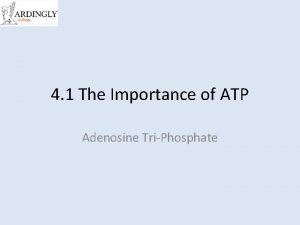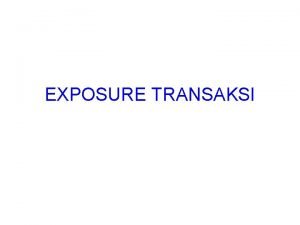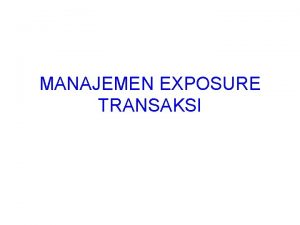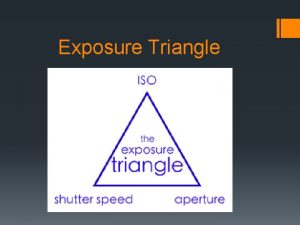The Radius Of Exposure The FEI is converted








- Slides: 8

The Radius Of Exposure The F&EI is converted to a Radius of Exposure by multiplying the F&EI by a factor of 0. 84 or by using the next figure. This is determined in either feet or meters. This radius of exposure is to be shown on plot plans for the Manufacturing Unit with the primary item of process equipment as the center of a circle using the Radius of Exposure. Circles should be drawn for each of the Process Units being analyzed in the Manufacturing Unit.

3. The Area Of Exposure v The Radius of Exposure defines an Area of Exposure. The Area of Exposure is calculated with the equation: Area = πR² ft 2 or m 2 v The Area of Exposure should be entered in the Process Unit Risk Analysis Summary line 3. v The area is that which contains equipment that could be exposed to a fire or to a fuel-air explosion generated in the Process Unit being evaluated. v For evaluation of equipment that could be damaged in a fire or explosion, actually a volume is considered. This volume is a cylindrical volume of the plant surrounding the Process Unit with the area being the Area of Exposure and the height being equal to the Radius of Exposure.

4. Value Of the Area Of Exposure v The value of the Area of Exposure is obtained from the Replacement Value of the property contained within it, including the inventory of material. Replacement Value = Original Cost X 0. 82 X Escalation Factor v The factor 0. 82 is an allowance for items of cost not subject to loss or replacement, such as site preparation, roads, underground lines and foundations, engineering expenses, etc. This factor may be changed if a more accurate estimate exists.

5. Determination of Damage Factor The Damage Factor is determined from the Process Unit Hazards Factor (F 3) and the Material Factor (MF). The Damage Factor represents the overall effect of fire plus blast damage resulting from a release of fuel or reactive energy from a Process Unit. For any calculation in which F 3 exceeds 8. 00, do not extrapolate from Figure. Use 8. 00 as the F 3 for obtaining the Damage Factor. As the Material Factor (MF) and the Process Unit Hazards Factor (F 3) increase, the Damage Factor will increase from 0. 01 to 1. 00.

6. Base Maximum Probable Property Damage (Base MPPD) With the Area of Exposure, the Value of the Area of Exposure and the Damage Factor determined, it is necessary to obtain same appropriate dollar value for the plant equipment within theoretical Area of Exposure (really volume of exposure) which represents the Base Maximum Probable Property Damage (Base MPPD). The Base MPPD is obtained by multiplying the values of lines 4 and 5 of the Process Unit Risk Analysis Summary. 7. Actual Maximum Probable Property Damage (Actual MPPD) The product of the Base MPPD and the Loss Control Credit Factor from the Loss Control Credit Factors Section will provide the Actual Maximum Probable Property Damage (Actual MPPD). This product represents the property damage loss that could result from an incident of reasonable magnitude with adequate (but not perfect) functioning of protective features.

8. Maximum Probable Days Outage (MPDO) v The estimate of Maximum Probable Days Outage (MPDO) is a necessary step in assessing the potential Business Interruption (BI) from a loss incident. v The dollar impact of Business Interruption can often times equal or exceed that of property damage, depending on inventory levels and product demand. v To obtain the MPDO value, it is necessary to have determined the Actual MPPD of the area and then to refer to the next Figure gives a correlation between MPDO and Actual MPPD. The data are derived from historical fire and explosion loss incidents, which also provided a basis for the Damage Factor.


10. Business Interruption (BI) The calculation for Business Interruption (BI) in U. S. dollars is done as follows: BI=(MPDO/30) x VPM x 0. 70 VPM is the Value of Production for the Month, and 0. 70 represents the fixed costs plus profits.














